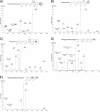Diversity within the O-linked protein glycosylation systems of acinetobacter species
- PMID: 24917611
- PMCID: PMC4159654
- DOI: 10.1074/mcp.M114.038315
Diversity within the O-linked protein glycosylation systems of acinetobacter species
Abstract
The opportunistic human pathogen Acinetobacter baumannii is a concern to health care systems worldwide because of its persistence in clinical settings and the growing frequency of multiple drug resistant infections. To combat this threat, it is necessary to understand factors associated with disease and environmental persistence of A. baumannii. Recently, it was shown that a single biosynthetic pathway was responsible for the generation of capsule polysaccharide and O-linked protein glycosylation. Because of the requirement of these carbohydrates for virulence and the non-template driven nature of glycan biogenesis we investigated the composition, diversity, and properties of the Acinetobacter glycoproteome. Utilizing global and targeted mass spectrometry methods, we examined 15 strains and found extensive glycan diversity in the O-linked glycoproteome of Acinetobacter. Comparison of the 26 glycoproteins identified revealed that different A. baumannii strains target similar protein substrates, both in characteristics of the sites of O-glycosylation and protein identity. Surprisingly, glycan micro-heterogeneity was also observed within nearly all isolates examined demonstrating glycan heterogeneity is a widespread phenomena in Acinetobacter O-linked glycosylation. By comparing the 11 main glycoforms and over 20 alternative glycoforms characterized within the 15 strains, trends within the glycan utilized for O-linked glycosylation could be observed. These trends reveal Acinetobacter O-linked glycosylation favors short (three to five residue) glycans with limited branching containing negatively charged sugars such as GlcNAc3NAcA4OAc or legionaminic/pseudaminic acid derivatives. These observations suggest that although highly diverse, the capsule/O-linked glycan biosynthetic pathways generate glycans with similar characteristics across all A. baumannii.
© 2014 by The American Society for Biochemistry and Molecular Biology, Inc.
Figures





Similar articles
-
Glycan-Tailored Glycoproteomic Analysis Reveals Serine is the Sole Residue Subjected to O-Linked Glycosylation in Acinetobacter baumannii.J Proteome Res. 2024 Jul 5;23(7):2474-2494. doi: 10.1021/acs.jproteome.4c00148. Epub 2024 Jun 8. J Proteome Res. 2024. PMID: 38850255
-
Open Database Searching Enables the Identification and Comparison of Bacterial Glycoproteomes without Defining Glycan Compositions Prior to Searching.Mol Cell Proteomics. 2020 Sep;19(9):1561-1574. doi: 10.1074/mcp.TIR120.002100. Epub 2020 Jun 23. Mol Cell Proteomics. 2020. PMID: 32576591 Free PMC article.
-
The Application of Open Searching-based Approaches for the Identification of Acinetobacter baumannii O-linked Glycopeptides.J Vis Exp. 2021 Nov 2;(177). doi: 10.3791/63242. J Vis Exp. 2021. PMID: 34806714
-
Mass spectrometry for protein sialoglycosylation.Mass Spectrom Rev. 2018 Sep;37(5):652-680. doi: 10.1002/mas.21555. Epub 2017 Dec 11. Mass Spectrom Rev. 2018. PMID: 29228471 Review.
-
Mucin-type O-glycosylation--putting the pieces together.FEBS J. 2010 Jan;277(1):81-94. doi: 10.1111/j.1742-4658.2009.07429.x. Epub 2009 Nov 17. FEBS J. 2010. PMID: 19919547 Review.
Cited by
-
Formylglycine-Generating Enzyme-Like Proteins Constitute a Novel Family of Widespread Type VI Secretion System Immunity Proteins.J Bacteriol. 2021 Oct 12;203(21):e0028121. doi: 10.1128/JB.00281-21. Epub 2021 Aug 16. J Bacteriol. 2021. PMID: 34398661 Free PMC article.
-
Genetic determinants of genus-level glycan diversity in a bacterial protein glycosylation system.PLoS Genet. 2019 Dec 23;15(12):e1008532. doi: 10.1371/journal.pgen.1008532. eCollection 2019 Dec. PLoS Genet. 2019. PMID: 31869330 Free PMC article.
-
Diversity and Function of Capsular Polysaccharide in Acinetobacter baumannii.Front Microbiol. 2019 Jan 9;9:3301. doi: 10.3389/fmicb.2018.03301. eCollection 2018. Front Microbiol. 2019. PMID: 30687280 Free PMC article.
-
A platform for glycoengineering a polyvalent pneumococcal bioconjugate vaccine using E. coli as a host.Nat Commun. 2019 Feb 21;10(1):891. doi: 10.1038/s41467-019-08869-9. Nat Commun. 2019. PMID: 30792408 Free PMC article.
-
Glycopeptide-Centric Approaches for the Characterization of Microbial Glycoproteomes.Methods Mol Biol. 2022;2456:153-171. doi: 10.1007/978-1-0716-2124-0_11. Methods Mol Biol. 2022. PMID: 35612741
References
-
- Gaynes R., Edwards J. R. (2005) Overview of nosocomial infections caused by gram-negative bacilli. Clin. Infect. Dis. 41, 848–854 - PubMed
-
- Cisneros J. M., Rodriguez-Bano J. (2002) Nosocomial bacteremia due to Acinetobacter baumannii: epidemiology, clinical features, and treatment. Clin. Microbiol. Infect. 8, 687–693 - PubMed
-
- Maragakis L. L., Perl T. M. (2008) Acinetobacter baumannii: epidemiology, antimicrobial resistance, and treatment options. Clin. Infect. Dis. 46, 1254–1263 - PubMed
-
- Towner K. J. (2009) Acinetobacter: an old friend, but a new enemy. J. Hosp. Infect. 73, 355–363 - PubMed
Publication types
MeSH terms
Substances
LinkOut - more resources
Full Text Sources
Other Literature Sources
Molecular Biology Databases

